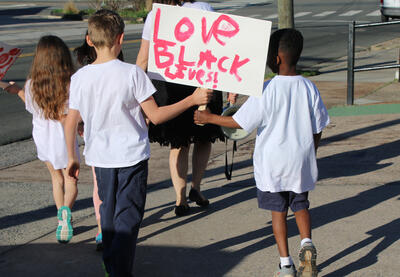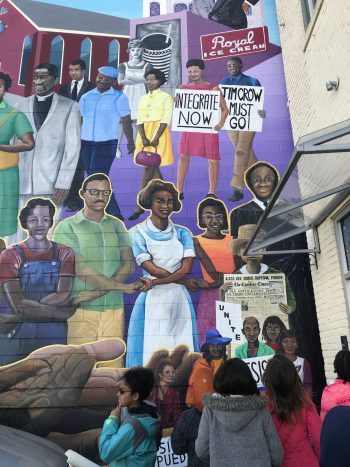Young people are showing us every day what we should already know—that they are capable of understanding the relationship between power and oppression in the intricacies of their lived experiences.
Teaching in the Durham, North Carolina, community helped me recognize young people’s capacity to understand and respond to social injustice with measured, creative and nuanced strategies for change. When a Confederate monument was toppled down the street from our school, my students researched the history of racial violence in our community. When students at a neighboring school witnessed Immigration and Customs Enforcement (ICE) raids, my students wrote letters of comfort and support for that school community. When confronted with the narrative that “all lives matter,” my students painted a mural at a community park that said, “Care About Black Lives.”
And the recent work of students at New York’s Fieldston School for Ethical Culture reminded me again of the need to support student-led social action. After a video surfaced of white Fieldston students using racist language, students of color and white students occupied the administration office to demand the adoption of 20 necessary changes—and got them.
The Learning for Justice Social Justice Standards build up to five action-oriented outcomes, and the Fieldston students exemplified every one of them in their work for social change. Learn about all of the standards here.
Our responsibility as educators is to be “keepers of the tape”: We must provide our students with the necessary tools—the tape—to create their own pathways to problem-solving and to craft their own solutions. We don’t have all the answers, and our young people are inheriting a world that is inequitable and unjust. As educators, it’s vital that we share the lessons we’ve learned and then get out of the way of students’ leadership.
When I learned that my own teaching “best practices” were better translated as choices than canon, my students were able to choose how they needed to respond to social injustice. Here’s what I’ve learned.
Allow for a full and honest portrayal of social activism, organizing and resistance to injustice.
Provide historical and contemporary examples of ways people solve problems in their communities—locally, nationally and globally. Avoid assigning moral value to tactics. For example, when it comes to police violence, many students are involved in or affected by protests that are characterized as inappropriate or “uncivil” responses to injustice. It’s important to make space for the many ways that young people are seeing, understanding, coping with and responding to injustice.
Remember that many students are resisting their real-life conditions, and highlight those doing the work.
Many young people have to resist their very real lived experiences. In Durham, Wildin Acosta, who continues to navigate his long-term path for documented status, had to advocate for his own stay of removal after being detained by Immigration and Customs Enforcement on his way to school. And his teachers, fellow students and larger community organized and advocated for him.
Frustrated with the lack of literature in her school that reflected her identities and tired of books about “white boys and dogs,” Marley Dias launched a campaign to collect #1000BlackGirlBooks that sparked international support. Her work inspired young people to reflect on representations of race, gender and other marginalized identities in their classrooms and libraries and propelled them to organize their own book drives.
And students all over the country are working to end gun violence in their communities, solve the problems that contribute to mass incarceration and tear down monuments to white supremacy. Teach about these young change makers, and let your students know that they have the power to make change, too.
Emphasize that social action is happening and can happen right now.
There is a tendency to place social action exclusively in the past. We teach about the civil rights movement as a finality and not one of many histories of resistance. For example, teaching about Brown v. Board of Education presents an opportunity to inform our students about how the past affects their present. Student activist Asean Johnson does exactly that in his analysis of Chicago Public School closings.
Share strategies for communicating and amplifying your message and achieving your demands.
In the past few months, we have seen students use traditional models for communicating their needs. Sunrise Movement students visited Senator Dianne Feinstein to share their support of the New Green Deal and communicated their personal investment in the issue while navigating stern questioning with passion and sincerity.
But we’ve also seen students use other models for enacting change throughout our history. In 1963, Birmingham students marched in the streets to highlight racist inequities and demand a meeting with the mayor. And much more recently, my own students in Durham produced The Migrant Story, a school newspaper that humanized immigrant narratives. UNC-Chapel Hill students removed a Confederate statue. And students at New York’s Bank Street College, including its School for Children, removed Columbus Day and instated Indigenous Peoples' Day.
There are a variety of strategies outside of legislative change for communicating and amplifying your message and achieving your demands.
Do Something
“Do Something” student tasks ask students to demonstrate their anti-bias awareness and civic competency by applying their literacy and social justice knowledge in an authentic, real-world context. Learn more here.
Honor the reality that existence is resistance.
For many of our students who are directly affected by anti-black state violence, racial terrorism, class stratification and policing of bodies and identities, we must respect that their very existence—their survival—is an act of resistance. Feminist writer bell hooks details this reality powerfully in her memoir when she describes integrating white schools: “[W]e think that we will be the first to die, to lay our bodies down. We feel despair and long for the days when school was a place where we learned to love and celebrate ourselves, a place where we were number one.”
Let us remember young people’s enduring roles as change makers—and our crucial roles in supporting them.
Bernal-Martinez is a former teaching and learning specialist for Learning for Justice.


